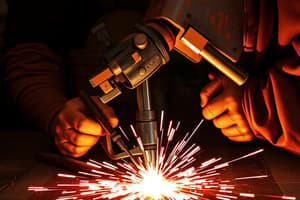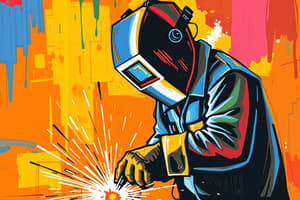Podcast
Questions and Answers
What does the Qualification section of the document outline?
What does the Qualification section of the document outline?
- Minimum acceptance criteria for test samples
- Requirements for welding personnel qualification (correct)
- Types and sizes of test samples
- Requirements for fabrication methods
Which of the following is NOT typically provided in the Fabrication section?
Which of the following is NOT typically provided in the Fabrication section?
- Qualification testing requirements (correct)
- Workmanship standards
- Information on fabrication methods
- Testing methods
What are some essential variables that may govern the extent of qualification in welding?
What are some essential variables that may govern the extent of qualification in welding?
- Variations in fabrication methods
- Testing locations
- Qualifications of welding personnel
- Type and thickness of base metal (correct)
Which part of the document typically provides information on design requirements for welded connections?
Which part of the document typically provides information on design requirements for welded connections?
What does the Qualification section specify regarding changing limitations?
What does the Qualification section specify regarding changing limitations?
What is typically outlined in the Welding Procedure Specification (WPS) according to the text?
What is typically outlined in the Welding Procedure Specification (WPS) according to the text?
What does a Welding Procedure Specification (WPS) provide directions for?
What does a Welding Procedure Specification (WPS) provide directions for?
What is the purpose of WPS qualification?
What is the purpose of WPS qualification?
What does a Procedure Qualification Record (PQR) document?
What does a Procedure Qualification Record (PQR) document?
When notch toughness is required for procedure qualification, what should be recorded in the PQR?
When notch toughness is required for procedure qualification, what should be recorded in the PQR?
What must be documented in a Completed PQR?
What must be documented in a Completed PQR?
How many WPSs can be prepared from one Procedure Qualification Record (PQR)?
How many WPSs can be prepared from one Procedure Qualification Record (PQR)?
What type of information does the Welding Procedure Specification (WPS) typically provide?
What type of information does the Welding Procedure Specification (WPS) typically provide?
What aspect of qualification does the Qualification section specify?
What aspect of qualification does the Qualification section specify?
In the context of welding, what is the purpose of Procedure Qualification Record (PQR)?
In the context of welding, what is the purpose of Procedure Qualification Record (PQR)?
What is typically NOT provided in the Fabrication section of the document?
What is typically NOT provided in the Fabrication section of the document?
Which one of these variables governs the extent of qualification in welding?
Which one of these variables governs the extent of qualification in welding?
What does the document typically provide regarding welder performance testing requirements?
What does the document typically provide regarding welder performance testing requirements?
Who is responsible for uploading SATIP and SAIC applicable to projects?
Who is responsible for uploading SATIP and SAIC applicable to projects?
Which role responds and closes RFIs issued by the Contractor?
Which role responds and closes RFIs issued by the Contractor?
What is the responsibility of the SAPMT Representative Role?
What is the responsibility of the SAPMT Representative Role?
Which user can view RFI and surveillance/logbook entries, approve SATIP and SAIC, and assign the standard cut-off date?
Which user can view RFI and surveillance/logbook entries, approve SATIP and SAIC, and assign the standard cut-off date?
Who has the responsibility to execute the escalation process of Violation Logbook Entry to Company NCR?
Who has the responsibility to execute the escalation process of Violation Logbook Entry to Company NCR?
Which role records rebuttals to PID replies and responds to surveillance/logbook entries?
Which role records rebuttals to PID replies and responds to surveillance/logbook entries?
Flashcards are hidden until you start studying
Study Notes
Welding Procedure Specification (WPS) and Procedure Qualification Record (PQR)
- A single WPS can cover multiple PQRs, e.g., one WPS can cover a thickness range of 1.6 mm to 32 mm if PQRs are available for 1.6 mm to 4.8 mm and 4.8 mm to 32 mm thickness ranges.
- WPS specifies the conditions (ranges) under which welding must be performed, known as variables.
- Essential variables in WPS include:
- Change in qualified thickness
- Change in P number
- Change in F number of filler metal
- Change in A number of filler metal
- Change in deposited metal thickness
- Decrease of more than 100 F in preheat
Weld Orientation and Groove Positions
- Plate groove positions: 1G, 2G, 3G, 4G
- Pipe groove positions: 1G, 2G, 5G, 6G
- Plate fillet positions: 1F, 2F, 3F, 4F
- Pipe fillet positions: 1F, 2F, 2FR, 4F, 5F
Base Metal Classification
- Base Metal P Numbers:
- P1 - P11: Steel
- P21 - P25: Al alloys
- P31 - P35: Cu alloys
- P41 - P47: Ni alloys
- P51 - P53: Ti alloys
- P61 - P62: Zr alloys
- Group number classification of metals within P numbers for procedure qualification, considering notch toughness requirements
Filler Metal Classification
- Filler Metal F Numbers: based on usability characteristics (ability of welders to make satisfactory welds)
- Filler Metal A Numbers: based on chemical composition
- A1, A2, A3, A4, A5, A6, A7, A8, A9, A10, A11, A12
- Specific A numbers correspond to specific alloy compositions (e.g., mild steel, Cr-Mo steel, Cr-Mo-V steel, etc.)
Heat Treatment
- Preheat temperature: minimum temperature of the workpiece in the weld zone immediately before welding
- Interpass temperature: maximum temperature of the weld during welding and between passes in a multi-run weld
- Preheat maintenance temperature: minimum temperature in the weld zone to be maintained during welding interruptions
- Post-weld heat treatment (PWHT): applied to some welded steels to ensure suitable properties for intended applications
Welding Inspectors and Heat Treatment
- Welding inspectors need to be familiar with material test certificates and heat treatment principles
- Tasks of monitoring thermal cycles and checking heat treatment records are often delegated to welding inspectors
Studying That Suits You
Use AI to generate personalized quizzes and flashcards to suit your learning preferences.




